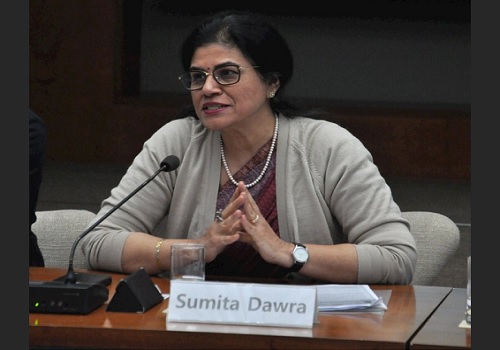Agri Commodity Technical Report 27 October 2022 - Geojit Financial Services

Follow us Now on Telegram ! Get daily 10 - 12 important updates on Business, Finance and Investment. Join our Telegram Channel
SPICES
* Mixed moved were seen in NCDEX spices complex on Tuesday. Turmeric plunged more than one per cent on profit booking after the recent rise to more than two month high. Jeera futures traded firm on expectation of rise in demand amidst fall in supplies. Coriander futures too inch up, though it continued to move range bound awaiting fresh cues for further directions.
* According to the Spices Board, India exported 572890.71 tons of spices during Apr-Aug 2022, down by 14 per cent, compared to 666540.53 tons exported during the same time period a year ago. Export of jeera stood at 91505.49 tons, down by 26 per cent, while that of coriander is seen at 18557.72 , down by 12 per cent. In the meantime, both turmeric and small cardamom exports rose by 15 respectively and pepper exports increased seven per cent. Small cardamom export stood at 3794.69 tons, while that of turmeric and pepper was 74393.62 and 9587.86 tons respectively.
* The value of India's spices market is expected to rise to 1 trln rupees by 2025 from 800 bln rupees this year, with the share of the organised sector likely to reach 50% from 38%, according to experts at the National Spice Conference. Currently, the value of the organised segment is pegged at 300 bln rupees. Improved quality, introduction of smaller stock-keeping units and increased shelf life of spices is one of the major reasons for growth of the organised segment, Ramkumar Menon, chairman of World Spice Organisation, said at the conference.Growth prospects in the case of spices are high and branding plays an important role, as it not only makes a memorable impression on consumers, but allows customers and clients to know what to expect from a company. It is a way to distinguish oneself from competitors and clarify what makes one a better choice, according to a panel of experts at the conference. Currently, the branded spices market is growing at a compounded annual rate of 10-15%, against 7-10% in the case of the unorganised segment. India, the world's largest producer, exporter, and consumer of spices, produces 75 of its 109 varieties. Around 85% of the spices produced in India are consumed domestically. The country accounts for more than 48% of global demand.
* Production of spices in India is likely to have declined 1.5% on year to 10.9 mln tn in 2021-22 (Jul-Jun), according to data from Spices Board India. The country had produced 11.0 mln tn of spices in the previous year. Among the complex, a major rise in production was pegged in turmeric. The board has pegged turmeric production at 1.33 mln tn, up 18.4% on year. Jeera production was seen at 725,651 tn, down 8.8% on year due to lower acreage in Rajasthan and Gujarat, the key producer. Production of chilli, counted as one of the largest exported and produced spices in the country, is projected at 1.9 mln tn, compared with 2.0 mln tn a year ago. Production of pepper is seen at 60,000 tn, down 7.7% on year, while the output of small cardamom is seen rising by 3.6% on year to 23,340 tn, data showed.

COTTON
* The US Department of Agriculture has lowered its estimate for global cotton production in 2022-23 (Aug-Jul) to 118.1 mln bales (1 US bale = 218 kg) from 118.4 mln bales projected a month ago. The reduction in the estimate is attributed to decline in production in Pakistan and Benin, the department said in its World Agricultural Supply and Demand Estimates report for October. Global cotton consumption is seen at 115.6 mln bales in 2022-23, as against 118.6 mln bales a month ago, due to a fall in demand from China, India, Pakistan, Turkey, Mexico and Vietnam. Global exports are estimated at 43.6 mln bales, down from 44.6 mln bales in the previous month. The agency has raised its 2022-23 global ending stocks estimate to 87.9 mln bales from 84.6 mln bales last month. For India, the agency has maintained its 2022-23 production estimates at 27.5 mln bales. Domestic consumption estimate is seen at 24.0 mln bales, down from 25 mln bales projected last month. Exports have been lowered to 3.5 mln bales from 3.7 mln bales.
* Cotton ending stocks in India for 2022-23 are now seen at 10.2 mln bales, higher than 8.9 mln bales projected a month ago, the report said.The farm ministry today pegged the country's kharif foodgrain output in 2022-23 (Jul-Jun) at 149.9 mln tn, according to the first advance estimates released today. Cotton output in 2022-23 is pegged at 34.2 mln bales, as against 36.2 mln bales in 2021-22. But in its fourth advance estimate for 2021-22, the government had lowered its cotton output view to around 31.2 mln bales.
* The area under cotton across India in 2022-23 (Jul-Jun) season was over 12.7 mln ha as of Thursday, up 7.5% from a year ago, data from the farm ministry showed. Sowing has been completed in northern states and acreage in Haryana, the top producer in the region, fell 5.4% on year to 650,473 ha. In Punjab, it fell 2.4% to 248,000 ha. Inadequate power supply for irrigationand non-availability of canal water during the initial sowing stage led to a drop in acreage in the northern states, experts said. In Gujarat, acreage rose to 2.5 mln ha as against 2.2 mln ha a year ago. In Maharashtra, the area under the crop increased 7.3% on year to 4.2 mln ha, while in Telangana, it fell 2.2% to 2.01 mln ha. Gujarat is the top producer of cotton in India, followed by Maharashtra and Telangana. Together, Gujarat and Maharashtra account for 50-55% of the country's total production.
* According to a circular from MCX, the exchange is in process of modifying the Cotton contract specification. Accordingly, with effect from August 29, 2022, no fresh positions will be permitted in Cotton January 2023 expiry contract which has currently nil open interest. Cotton February 2023 expiry and subsequent expiry contracts will temporarily not be launched for trading till such time the revised contract specification is finalized. No changes for other running Cotton contracts with Open Interest.
* The US Department of Agriculture has scaled down its estimate for the global cotton production in 2022-23 (Aug-Jul) to 117.0 mln bales (1 US bale = 218 kg) from 120.1 mln bales projected a month ago. The cut in the estimate is attributed to a lower production in the US, the agency said in its World Agricultural Supply and Demand Estimates report for August. Production in the US is seen lower due to a severe drought, which is likely to affect the yield. Texas, the largest cotton-producing state in the US is likely to harvest 2.9 mln bales of cotton this year, compared to 7.7 million bales in 2021. Production in the US is estimated at 12.6 mln bales in 2022-23, which is sharply lower from 17.5 mln bales a year ago. Global cotton consumption is now seen at 119.1 mln bales in 2022-23, against an estimate of 119.9 mln bales a month ago, owing to a fall in demand from Turkey, Pakistan, Bangladesh, and Vietnam. Global exports are estimated at 44.6 mln bales, against 46.4 mln bales projected a month ago. The agency has lowered its 2022-23 global ending stocks estimate to 82.8 mln bales. For India, the agency has maintained its estimate for production in 2022-23 at 27.5 mln bales. The domestic consumption estimate is seen at 25.0 mln bales. Exports are also maintained at 3.7 mln bales. Cotton ending stocks in India for 2022-23 are now seen at 8.8 mln bales, higher than 8.4 mln bales projected a month ago, it said.

OTHERS
* The government has over 4.3 mln tn of pulses in its buffer stock, nearly double the strategic norm, Consumers Affairs Secretary Rohit Kumar Singh said at a press conference today. As per norms, the Centre targets a buffer stock of 2.3 mln tn of pulses. At nearly 3.1 mln tn, chana currently has the highest share in the pulses buffer stock, followed by moong and urad. In the 2022-23 (Apr-Mar) marketing season, chana procurement has been higher due to bumper production of pulses. Due to higher procurement and ample stocks from the previous two seasons, the government had allocated chana to states at a discount of 8 rupees per kg over the issue price. So far, the Centre has allocated 88,600 tn of chana to Uttar Pradesh, Gujarat, Himachal Pradesh and Tamil Nadu for various welfare schemes such as the midday meal scheme, the public distribution system, and integrated child development programmes.
* The Union Cabinet today approved 2-9% hike in the minimum support price of six rabi crops for the coming marketing season starting April.The minimum support price of wheat has been increased by 5.5% to 2,125 rupees per 100 kg, while that of chana was raised by 2.0% to 5,335 rupees per 100 kg, the government said. Wheat, the crucial rabi crop, accounts for over 70% of the rabi foodgrain output, and chana is the largest rabi pulse crop. Minimum support prices, or the rates at which the government buys crops from farmers in case prices slip in the market, gives security and direction to growers in terms of realisation from their produce. They also help boost production of a desired crop. The Cabinet also approved increasing minimum support price of mustard by 7.9% to 5,450 rupees per 100 kg, and for masur by 9.1% to 6,000 rupees per 100 kg. The support price for barley was increased by 6.1% to 1,735 rupees per 100 kg. In the fourth advance estimate, the government predicted output of wheat in the 2021-22 (Jul-Jun) crop year at 106.8 mln tn, while oilseed production is pegged at 37.69 mln tn. Pulses output was seen at 27.69 mln tn, against 27.75 mln tn estimated in the third advance estimate.
* The government has pegged the output of pulses at 8.4 mln tn, significantly lower than 9.5 mln tn estimated in the first advance estimate of last year. As of Thursday, the area under pulses fell 4.1% to 13.2 mln ha across the country. The drop in acreage of pulses is a cause for concern as it could lead to higher prices in retail markets during the pulses marketing season. Farmers have shifted to oilseeds and cotton this kharif season due to higher price realisations of the crops and delay in monsoon rainfall in June and July.
* India’s Guar split exports decreased in the month of July’2022 by 32% to 5,882 MT as compared to 8,620 MT previous month. However, the Guarsplit shipments up by 3.92% in July’22 compared to the same period last year. Out of the total exports, around 4,220 MT (71.74%) bought by China, 302 MT (9.98%) bought by USA. : India’s Guar gum exports decreased in the month of July 2022 by 23% to 22,501 MT compared to 29,236 MT during previous month. However, the gum shipments were up by 36.12% in July 2022 compared to the same period last year. Out of the total exported quantity, around 5737 MT (25.50%) was bought by the US, Russia bought 4077 MT (18.12%), China 1,884 MT (8.37%), and Germany 2,270 MT (10.09%). Export demand declined amid correction in crude oil prices. We expect Guar gum export in Aug’22 around 22,000-25,000 tonnes, as WTI crude oil corrected by 9.72% in Aug’22.

OIL AND OILSEEDS
• The Solvent Extractors' Association of India has urged the government to withdraw the storage control order and allow futures trading in crude soybean and palm oil for hedging purposes to check falling prices. Soybean and groundnut prices are likely to fall below their minimum support prices by Diwali because of higher arrivals. This will affect farmers and discourage them to grow oilseeds in the future, Ajay Jhunjhunwala, president of the association said in a letter to the government. The association has suggested that the storage control order be withdrawn as it is restricting large companies and traders from buying edible oils in bulk, which directly supports market prices. It has also asked the government to allow futures trading at least in crude soybean oil and crude palm oil. Futures trading allows traders to hedge against price volatility, Jhunjhunwala said.The Cabinet approved increasing minimum support price of mustard by 7.9% to 5,450 rupees per 100 kg.
• India's soymeal exports in September rose 287.5% on year to 31,000 tn, the Soybean Processors Association of India said. For 2021-22 (OctSep), soymeal exports plunged to 650,000 tn from 1.9 mln tn in the previous year. Soymeal is primarily used as poultry and livestock feed. Indian soymeal is non-genetically modified and considered rich in protein.
• India's exports of oilmeals rose 31% on year to 240,669 tn in September, according to data released by the Solvent Extractors' Association of India today. During the first six months of the financial year that began on Apr 1, exports of oilmeals rose 39% on year to 1.8 mln tn. The rise in exports of oilmeals was mainly attributed to the surge in exports of mustard meal that spiked to 1.2 mln tn in Apr-Sep from 605,355 tn in the year-ago period. However, in case of soymeal, exports remained subdued as "India is out priced in the international market", the association said in a release. Exports of soymeal plunged to 121,976 tn in Apr-Sep compared with 161,588 tn a year ago.
• The global oilseed output is projected to increase 0.3% on month to 646.6 mln tn in 2022-23 (May-Apr), the US Department of Agriculture said in its October report. For 2022-23 (May-Apr), the agency estimated global oilseed output at 644.8 mln tn in September. Higher output of soybean and mustard crop is likely to support overall production, the agency said. The agency has projected global soybean output to rise by 1.2 mln tn month-on-month to nearly 391.0 mln tn in 2022-23. Soybean production in Brazil is estimated at 152 mln tn against 149 mln tn projected last month, while that in Argentina is projected unchanged at 51 mln tn in October. However, soybean production in the US is likely to fall to 117.38 mln tn from 119.2 mln tn in September due to lower yields. Brazil is the world's top producer of soybean, followed by the US and Argentina. The agency has also scaled up its estimate for soybean's global ending stocks to 100.5 mln tn from 98.9 mln tn estimated in September, with most of the rise in Brazil. The estimate for global soyoil production for 2022-23 has also been revised slightly upwards to 61.9 mln tn from 61.4 mln tn predicted in September. However, the estimate for global soyoil exports in 2022-23 has been revised marginally lower to 12.90 mln tn from 12.97 mln tn estimated the previous month. Additionally, the department has projected global soymeal output for 2022-23 at 258.6 mln tn, up from 256.7 mln tn month-on-month. The agency estimates global exports of soymeal to be a tad lower at 69.93 mln tn compared with 69.98 mln tn pegged in September. Soymeal is a derivative of soybean. It is manufactured by crushing the oilseed and is mainly used in production of poultry feed.
• India's vegetable oil imports declined 7% year-on-year to 1.6 mln tn in September, the Solvent Extractors' Association of India said today. For Nov-Sep, imports of vegetable oil were at 13.0 mln tn, against 12.5 mln tn in the year-ago period. The vegetable oil basket consists of edible and non-edible oils. Edible oil imports for Nov-Sep stood at 12.7 mln tn, against 12.1 mln tn in the year-ago period, the data showed. The edible oil import basket comprises crude and refined palm oils, crude soyoil, sunflower oil, and mustard oil. India imports palm oil from Indonesia and Malaysia, and soyoil from Argentina. Sunflower oil is imported from Ukraine and Russia, and canola oil from Canada. India is the world's largest importer of edible oils.
• Crude palm oil output in Malaysia rose 2.6% on month to 1.8 mln tn in September, data from the Malaysian Palm Oil Board showed. Export of palm oil in September went up 9.3% on month to 1.4 mln tn, while outbound shipments of biodiesel increased 11.7% on month to 29,324 tn, the data showed. Palm oil is used to manufacture biofuel. Total stocks of palm oil in the country were up 10.5% on month at 2.3 mln tn as of Sep 30.
• India's soybean output is estimated to rise 1.3% at 12.0 mln tn in 2022-23 (Jul-Jun), the Soybean Processors Association of India said in its first advance estimate. The association's estimate is lower than the government's projection of 12.9 mln tn. The rise in soybean crop output in the ongoing crop year has been attributed to higher productivity. SOPA sees the soybean yield increasing at 1,051 kg per ha as against 991 kg per ha in the previous season. However, in 2022-23, soybean acreage is seen lower at 11.5 mln ha versus 12.0 mln ha in the previous season. "Water logging has been seen in low-lying areas of Maharashtra and Madhya Pradesh, causing yellowing of leaves and there may be some damage to crop and also yield loss in these areas," the association had said in a survey report earlier. According to data by the farm ministry, total area under the crop in the country is 12.1 mln ha. The condition of the crop sown throughout India, however, is seen normal to good, it had said. It classifies crop conditions in four categories—poor, normal, good, and very good. Soybean fields are mostly weed-free and there is no significant attack of insects or diseases, the association had said in the report. In Madhya Pradesh, the largest producer of the oilseed in the country, production is pegged slightly higher at 5.3 mln tn from 5.2 mln tn in the previous year. The yield in the state is seen increasing to 1,051 kg per ha from around 939 kg per ha last year, it said. Output in Maharashtra is seen marginally lower at 4.7 mln tn this year, as against 4.8 mln tn last year, due to a fall in yield it said. The yield in the state is seen falling to 1,080 kg per ha from 1,102 kg per ha last year. The area under the crop in the state is seen at 4.3 mln ha in 2022-23 versus 4.4 mln ha in 2021-22, it said. Crop damage and a loss in yield are expected in some regions of Indore, Ujjain, Hoshangabad and Rewa in Madhya Pradesh and Maharashtra's Latur, Amravati and Nagpur. Production in Rajasthan is seen rising to 985,300 tn in the ongoing crop year as against 704,700 tn in the previous year, it said, adding that yield is pegged higher at 953 kg per ha versus 762 kg per ha in 2021-22.
• The Mustard Oil Producers Association of India has written to the Ministry of Finance, urging the removal of stock limits on oilseeds and resumption of futures trade in mustard oil and other edible oils, the association said in a release. "Due to the ban on futures trading, the industry has not been able to manage risks properly. This has resulted in losses," the association wrote in the letter. In December, the Securities and Exchange Board of India had banned futures trading of seven agricultural commodities, including mustard, soybean and crude palm oil, for a year to fight the rise in inflation.
• India's kharif acreage in 2022-23 (Jul-Jun) has ended 1% lower on year at 110.3 mln ha, according to data released by the farm ministry. The slight drop is due to lower area under crops such as rice, pulses and groundnut. The area under oilseeds so far is at 19.2 mln ha, compared with 19.4 mln ha a year ago, while the area under pulses is at 13.4 mln ha, as against 13.9 mln ha a year ago.
• The farm ministry today pegged the country's kharif foodgrain output in 2022-23 (Jul-Jun) at 149.9 mln tn, according to the first advance estimates released. The production view for soybean has been raised slightly to 12.9 mln tn, as against 12.7 mln tn pegged in the previous year's first advance estimate. Soybean accounts for over 52% of the kharif oilseed production basket.
• The Solvent Extractors’ Association of India has announced the formation of the Asian Palm Oil Alliance, a union of apex vegetable oil associations, at its 51st annual general meeting today. Associations from India, Pakistan, Sri Lanka, Bangladesh and Nepal signed a memorandum of understanding for the same today. "The alliance commits to work across the world to ensure that palm oil is recognised as high quality, economical and healthy vegetable oil, and also to change the negative image of palm oil," said Atul Chaturvedi, president of SEA. During the meeting, the SEA also appointed Ajay Jhunjhunwala as its new president.
• The Solvent Extractors' Association of India has written to the Securities and Exchange Board of India, urging for the resumption of futures trade in soybean oil and crude palm oil for risk management and price discovery mechanism, the association said in a release.
To Read Complete Report & Disclaimer Click Here
For More Geojit Financial Services Ltd Disclaimer https://www.geojit.com/disclaimer
SEBI Registration Number: INH200000345
Views express by all participants are for information & academic purpose only. Kindly read disclaimer before referring below views. Click Here For Disclaimer












 320-x-100_uti_gold.jpg" alt="Advertisement">
320-x-100_uti_gold.jpg" alt="Advertisement">












